Case Study: Laburnum Group's Challenges in Energy and Clothing Sectors
VerifiedAdded on 2022/10/08
|8
|2368
|65
Case Study
AI Summary
This case study examines the Laburnum Group, a major Australian company, and its challenges in the energy (Sapphire Energy) and clothing (AusCotton) sectors. The report analyzes inefficiencies in procurement and supply chain management. Sapphire Energy faces high carrying costs and ordering issues with its aluminium triplex cable supply, while AusCotton deals with supply chain issues and illegal manufacturing by contractors. The analysis delves into the use of Economic Order Quantity (EOQ) for inventory management. Recommendations include improving ordering systems, reducing carrying costs, and setting regulations for product manufacturing. The study highlights the importance of strategic decision-making and maintaining value for stakeholders. The report provides insights into the challenges and potential solutions for Laburnum Group's business portfolios, offering valuable information for business development and supply chain management strategies.
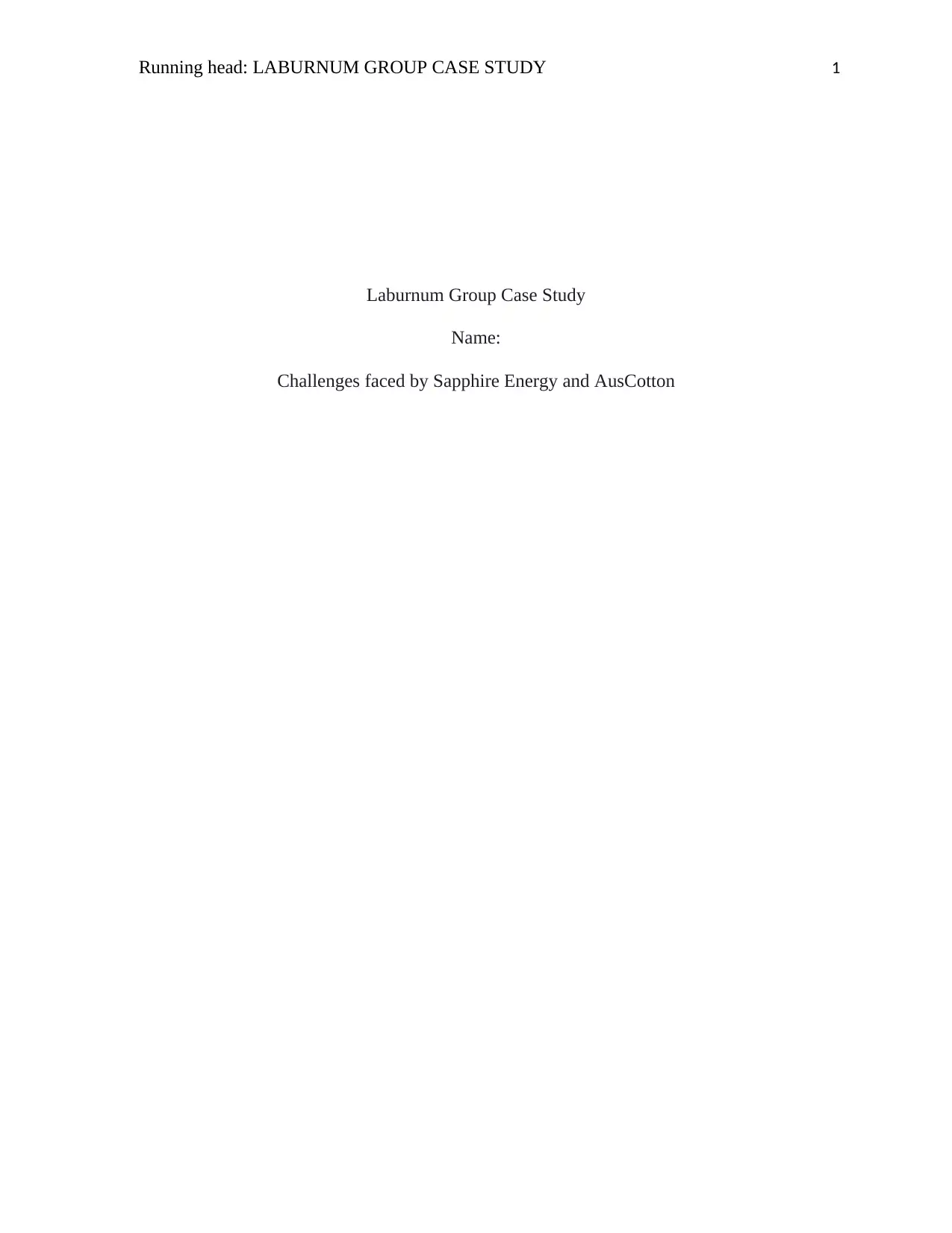
Running head: LABURNUM GROUP CASE STUDY 1
Laburnum Group Case Study
Name:
Challenges faced by Sapphire Energy and AusCotton
Laburnum Group Case Study
Name:
Challenges faced by Sapphire Energy and AusCotton
Paraphrase This Document
Need a fresh take? Get an instant paraphrase of this document with our AI Paraphraser
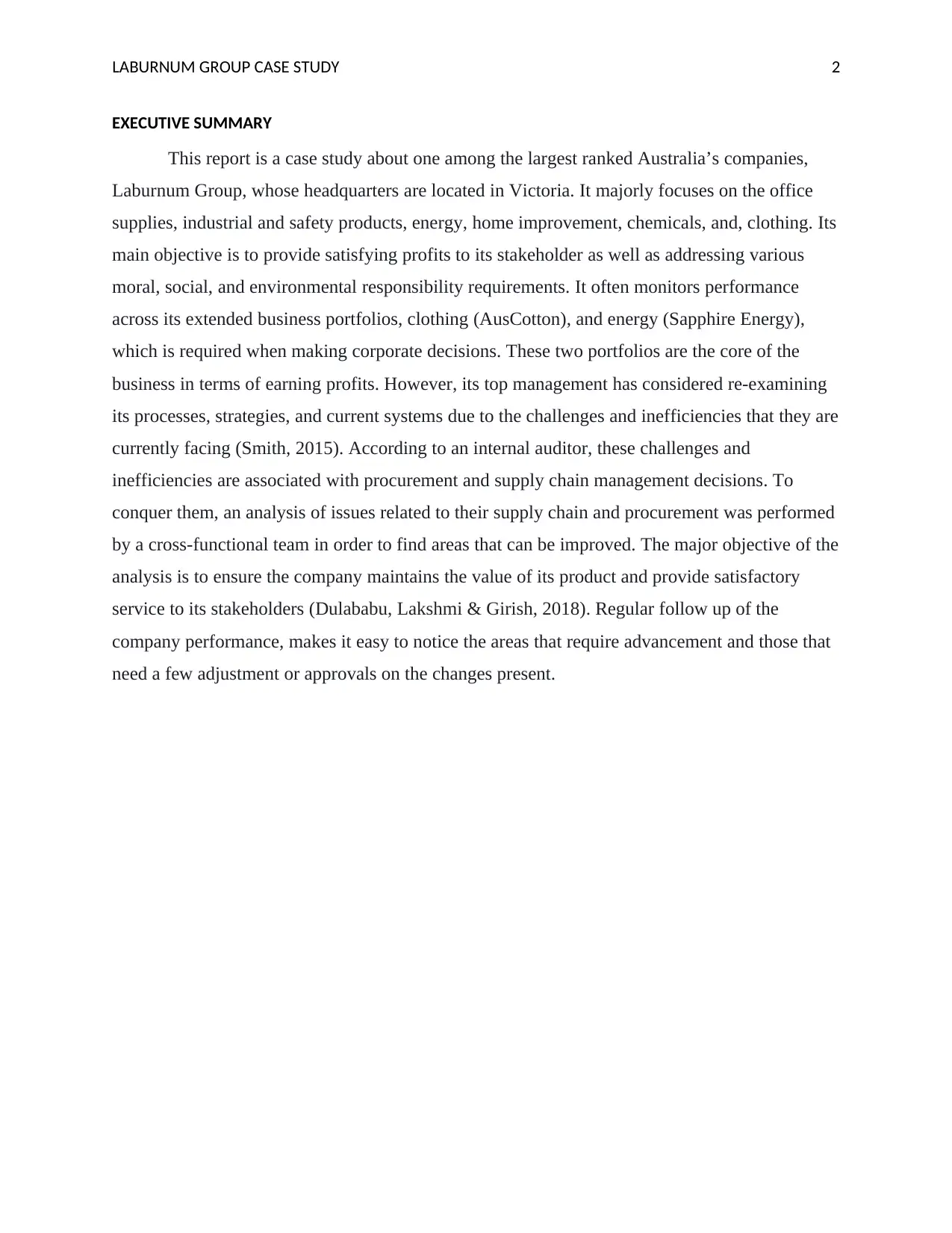
LABURNUM GROUP CASE STUDY 2
EXECUTIVE SUMMARY
This report is a case study about one among the largest ranked Australia’s companies,
Laburnum Group, whose headquarters are located in Victoria. It majorly focuses on the office
supplies, industrial and safety products, energy, home improvement, chemicals, and, clothing. Its
main objective is to provide satisfying profits to its stakeholder as well as addressing various
moral, social, and environmental responsibility requirements. It often monitors performance
across its extended business portfolios, clothing (AusCotton), and energy (Sapphire Energy),
which is required when making corporate decisions. These two portfolios are the core of the
business in terms of earning profits. However, its top management has considered re-examining
its processes, strategies, and current systems due to the challenges and inefficiencies that they are
currently facing (Smith, 2015). According to an internal auditor, these challenges and
inefficiencies are associated with procurement and supply chain management decisions. To
conquer them, an analysis of issues related to their supply chain and procurement was performed
by a cross-functional team in order to find areas that can be improved. The major objective of the
analysis is to ensure the company maintains the value of its product and provide satisfactory
service to its stakeholders (Dulababu, Lakshmi & Girish, 2018). Regular follow up of the
company performance, makes it easy to notice the areas that require advancement and those that
need a few adjustment or approvals on the changes present.
EXECUTIVE SUMMARY
This report is a case study about one among the largest ranked Australia’s companies,
Laburnum Group, whose headquarters are located in Victoria. It majorly focuses on the office
supplies, industrial and safety products, energy, home improvement, chemicals, and, clothing. Its
main objective is to provide satisfying profits to its stakeholder as well as addressing various
moral, social, and environmental responsibility requirements. It often monitors performance
across its extended business portfolios, clothing (AusCotton), and energy (Sapphire Energy),
which is required when making corporate decisions. These two portfolios are the core of the
business in terms of earning profits. However, its top management has considered re-examining
its processes, strategies, and current systems due to the challenges and inefficiencies that they are
currently facing (Smith, 2015). According to an internal auditor, these challenges and
inefficiencies are associated with procurement and supply chain management decisions. To
conquer them, an analysis of issues related to their supply chain and procurement was performed
by a cross-functional team in order to find areas that can be improved. The major objective of the
analysis is to ensure the company maintains the value of its product and provide satisfactory
service to its stakeholders (Dulababu, Lakshmi & Girish, 2018). Regular follow up of the
company performance, makes it easy to notice the areas that require advancement and those that
need a few adjustment or approvals on the changes present.
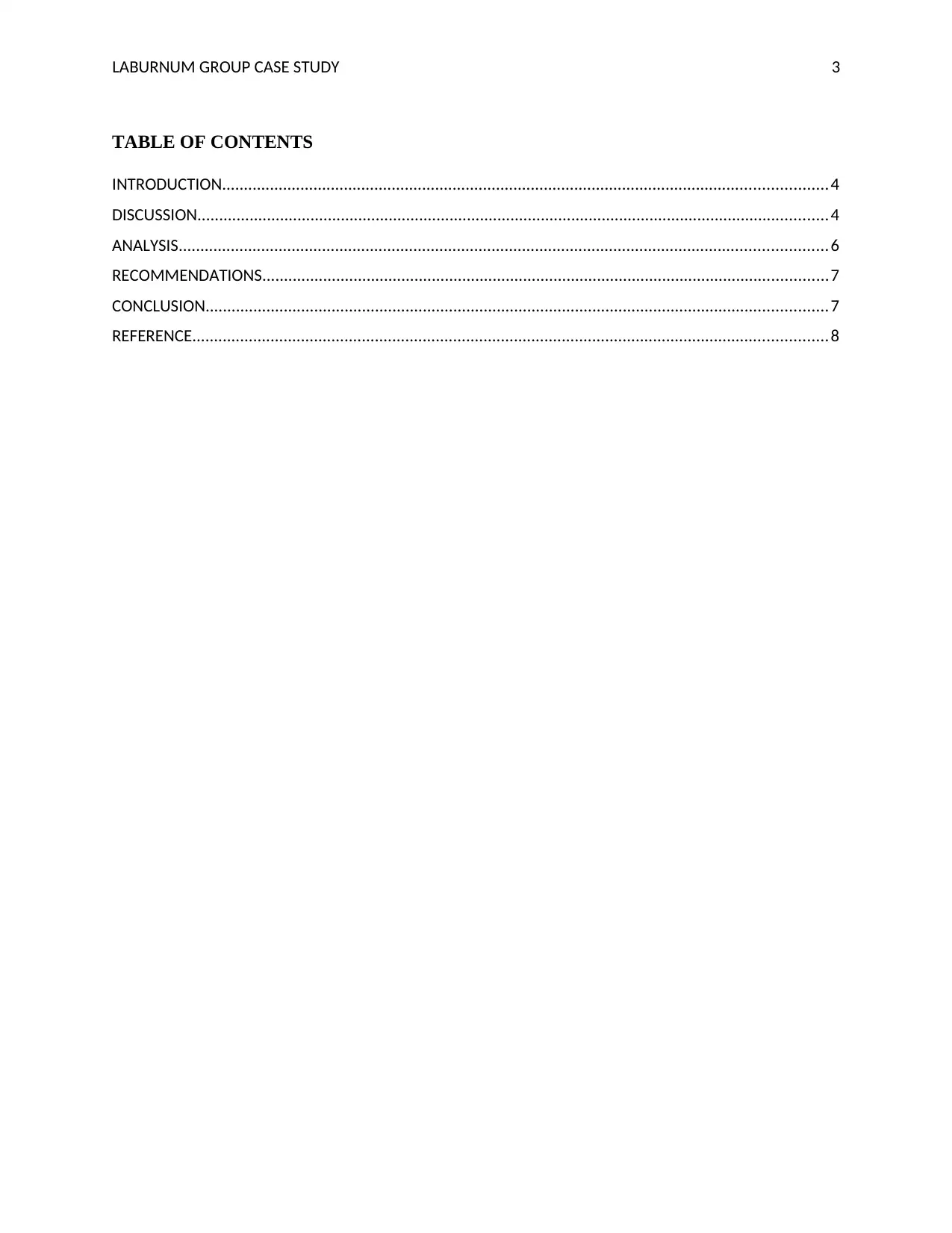
LABURNUM GROUP CASE STUDY 3
TABLE OF CONTENTS
INTRODUCTION...........................................................................................................................................4
DISCUSSION.................................................................................................................................................4
ANALYSIS.....................................................................................................................................................6
RECOMMENDATIONS..................................................................................................................................7
CONCLUSION...............................................................................................................................................7
REFERENCE..................................................................................................................................................8
TABLE OF CONTENTS
INTRODUCTION...........................................................................................................................................4
DISCUSSION.................................................................................................................................................4
ANALYSIS.....................................................................................................................................................6
RECOMMENDATIONS..................................................................................................................................7
CONCLUSION...............................................................................................................................................7
REFERENCE..................................................................................................................................................8
⊘ This is a preview!⊘
Do you want full access?
Subscribe today to unlock all pages.

Trusted by 1+ million students worldwide
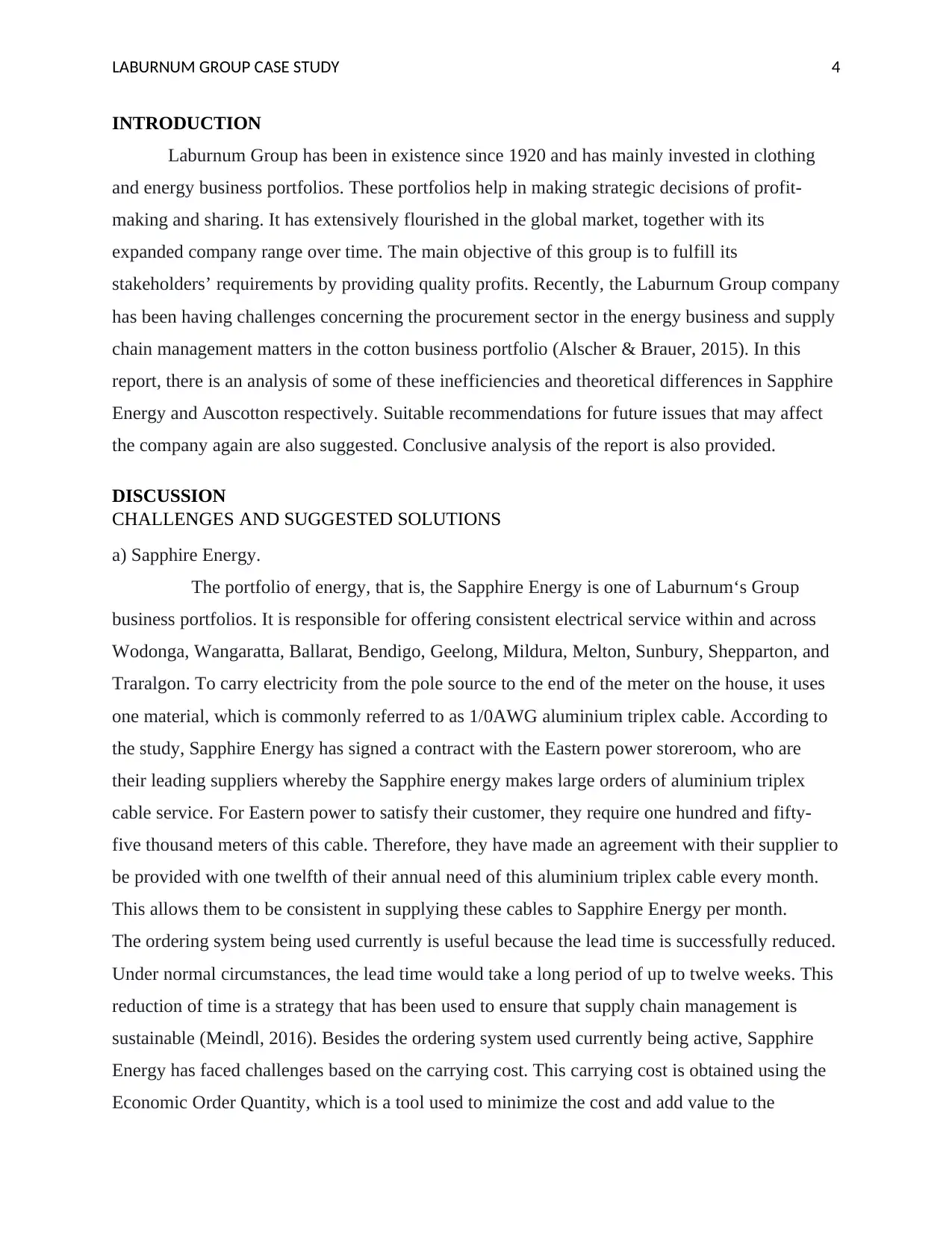
LABURNUM GROUP CASE STUDY 4
INTRODUCTION
Laburnum Group has been in existence since 1920 and has mainly invested in clothing
and energy business portfolios. These portfolios help in making strategic decisions of profit-
making and sharing. It has extensively flourished in the global market, together with its
expanded company range over time. The main objective of this group is to fulfill its
stakeholders’ requirements by providing quality profits. Recently, the Laburnum Group company
has been having challenges concerning the procurement sector in the energy business and supply
chain management matters in the cotton business portfolio (Alscher & Brauer, 2015). In this
report, there is an analysis of some of these inefficiencies and theoretical differences in Sapphire
Energy and Auscotton respectively. Suitable recommendations for future issues that may affect
the company again are also suggested. Conclusive analysis of the report is also provided.
DISCUSSION
CHALLENGES AND SUGGESTED SOLUTIONS
a) Sapphire Energy.
The portfolio of energy, that is, the Sapphire Energy is one of Laburnum‘s Group
business portfolios. It is responsible for offering consistent electrical service within and across
Wodonga, Wangaratta, Ballarat, Bendigo, Geelong, Mildura, Melton, Sunbury, Shepparton, and
Traralgon. To carry electricity from the pole source to the end of the meter on the house, it uses
one material, which is commonly referred to as 1/0AWG aluminium triplex cable. According to
the study, Sapphire Energy has signed a contract with the Eastern power storeroom, who are
their leading suppliers whereby the Sapphire energy makes large orders of aluminium triplex
cable service. For Eastern power to satisfy their customer, they require one hundred and fifty-
five thousand meters of this cable. Therefore, they have made an agreement with their supplier to
be provided with one twelfth of their annual need of this aluminium triplex cable every month.
This allows them to be consistent in supplying these cables to Sapphire Energy per month.
The ordering system being used currently is useful because the lead time is successfully reduced.
Under normal circumstances, the lead time would take a long period of up to twelve weeks. This
reduction of time is a strategy that has been used to ensure that supply chain management is
sustainable (Meindl, 2016). Besides the ordering system used currently being active, Sapphire
Energy has faced challenges based on the carrying cost. This carrying cost is obtained using the
Economic Order Quantity, which is a tool used to minimize the cost and add value to the
INTRODUCTION
Laburnum Group has been in existence since 1920 and has mainly invested in clothing
and energy business portfolios. These portfolios help in making strategic decisions of profit-
making and sharing. It has extensively flourished in the global market, together with its
expanded company range over time. The main objective of this group is to fulfill its
stakeholders’ requirements by providing quality profits. Recently, the Laburnum Group company
has been having challenges concerning the procurement sector in the energy business and supply
chain management matters in the cotton business portfolio (Alscher & Brauer, 2015). In this
report, there is an analysis of some of these inefficiencies and theoretical differences in Sapphire
Energy and Auscotton respectively. Suitable recommendations for future issues that may affect
the company again are also suggested. Conclusive analysis of the report is also provided.
DISCUSSION
CHALLENGES AND SUGGESTED SOLUTIONS
a) Sapphire Energy.
The portfolio of energy, that is, the Sapphire Energy is one of Laburnum‘s Group
business portfolios. It is responsible for offering consistent electrical service within and across
Wodonga, Wangaratta, Ballarat, Bendigo, Geelong, Mildura, Melton, Sunbury, Shepparton, and
Traralgon. To carry electricity from the pole source to the end of the meter on the house, it uses
one material, which is commonly referred to as 1/0AWG aluminium triplex cable. According to
the study, Sapphire Energy has signed a contract with the Eastern power storeroom, who are
their leading suppliers whereby the Sapphire energy makes large orders of aluminium triplex
cable service. For Eastern power to satisfy their customer, they require one hundred and fifty-
five thousand meters of this cable. Therefore, they have made an agreement with their supplier to
be provided with one twelfth of their annual need of this aluminium triplex cable every month.
This allows them to be consistent in supplying these cables to Sapphire Energy per month.
The ordering system being used currently is useful because the lead time is successfully reduced.
Under normal circumstances, the lead time would take a long period of up to twelve weeks. This
reduction of time is a strategy that has been used to ensure that supply chain management is
sustainable (Meindl, 2016). Besides the ordering system used currently being active, Sapphire
Energy has faced challenges based on the carrying cost. This carrying cost is obtained using the
Economic Order Quantity, which is a tool used to minimize the cost and add value to the
Paraphrase This Document
Need a fresh take? Get an instant paraphrase of this document with our AI Paraphraser
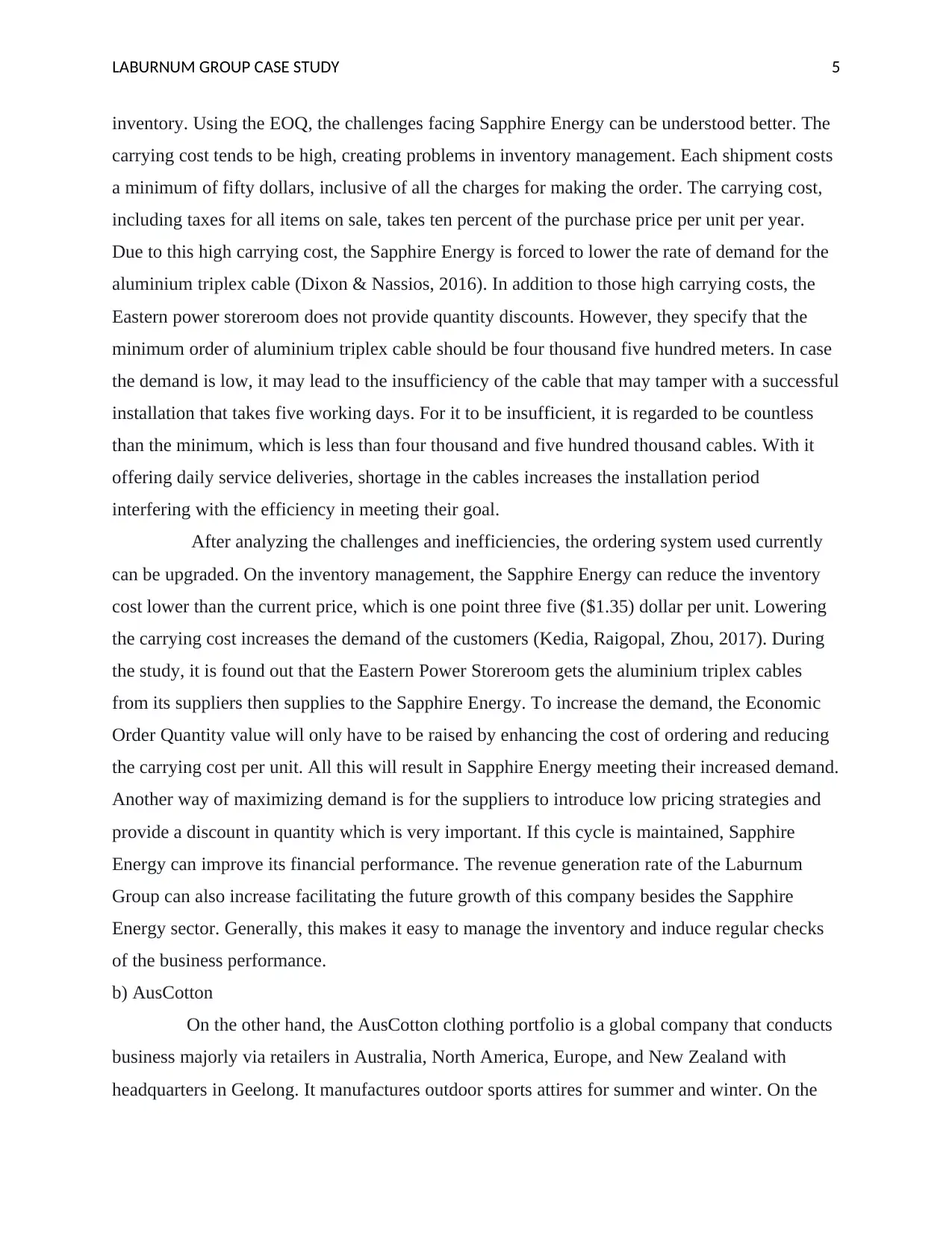
LABURNUM GROUP CASE STUDY 5
inventory. Using the EOQ, the challenges facing Sapphire Energy can be understood better. The
carrying cost tends to be high, creating problems in inventory management. Each shipment costs
a minimum of fifty dollars, inclusive of all the charges for making the order. The carrying cost,
including taxes for all items on sale, takes ten percent of the purchase price per unit per year.
Due to this high carrying cost, the Sapphire Energy is forced to lower the rate of demand for the
aluminium triplex cable (Dixon & Nassios, 2016). In addition to those high carrying costs, the
Eastern power storeroom does not provide quantity discounts. However, they specify that the
minimum order of aluminium triplex cable should be four thousand five hundred meters. In case
the demand is low, it may lead to the insufficiency of the cable that may tamper with a successful
installation that takes five working days. For it to be insufficient, it is regarded to be countless
than the minimum, which is less than four thousand and five hundred thousand cables. With it
offering daily service deliveries, shortage in the cables increases the installation period
interfering with the efficiency in meeting their goal.
After analyzing the challenges and inefficiencies, the ordering system used currently
can be upgraded. On the inventory management, the Sapphire Energy can reduce the inventory
cost lower than the current price, which is one point three five ($1.35) dollar per unit. Lowering
the carrying cost increases the demand of the customers (Kedia, Raigopal, Zhou, 2017). During
the study, it is found out that the Eastern Power Storeroom gets the aluminium triplex cables
from its suppliers then supplies to the Sapphire Energy. To increase the demand, the Economic
Order Quantity value will only have to be raised by enhancing the cost of ordering and reducing
the carrying cost per unit. All this will result in Sapphire Energy meeting their increased demand.
Another way of maximizing demand is for the suppliers to introduce low pricing strategies and
provide a discount in quantity which is very important. If this cycle is maintained, Sapphire
Energy can improve its financial performance. The revenue generation rate of the Laburnum
Group can also increase facilitating the future growth of this company besides the Sapphire
Energy sector. Generally, this makes it easy to manage the inventory and induce regular checks
of the business performance.
b) AusCotton
On the other hand, the AusCotton clothing portfolio is a global company that conducts
business majorly via retailers in Australia, North America, Europe, and New Zealand with
headquarters in Geelong. It manufactures outdoor sports attires for summer and winter. On the
inventory. Using the EOQ, the challenges facing Sapphire Energy can be understood better. The
carrying cost tends to be high, creating problems in inventory management. Each shipment costs
a minimum of fifty dollars, inclusive of all the charges for making the order. The carrying cost,
including taxes for all items on sale, takes ten percent of the purchase price per unit per year.
Due to this high carrying cost, the Sapphire Energy is forced to lower the rate of demand for the
aluminium triplex cable (Dixon & Nassios, 2016). In addition to those high carrying costs, the
Eastern power storeroom does not provide quantity discounts. However, they specify that the
minimum order of aluminium triplex cable should be four thousand five hundred meters. In case
the demand is low, it may lead to the insufficiency of the cable that may tamper with a successful
installation that takes five working days. For it to be insufficient, it is regarded to be countless
than the minimum, which is less than four thousand and five hundred thousand cables. With it
offering daily service deliveries, shortage in the cables increases the installation period
interfering with the efficiency in meeting their goal.
After analyzing the challenges and inefficiencies, the ordering system used currently
can be upgraded. On the inventory management, the Sapphire Energy can reduce the inventory
cost lower than the current price, which is one point three five ($1.35) dollar per unit. Lowering
the carrying cost increases the demand of the customers (Kedia, Raigopal, Zhou, 2017). During
the study, it is found out that the Eastern Power Storeroom gets the aluminium triplex cables
from its suppliers then supplies to the Sapphire Energy. To increase the demand, the Economic
Order Quantity value will only have to be raised by enhancing the cost of ordering and reducing
the carrying cost per unit. All this will result in Sapphire Energy meeting their increased demand.
Another way of maximizing demand is for the suppliers to introduce low pricing strategies and
provide a discount in quantity which is very important. If this cycle is maintained, Sapphire
Energy can improve its financial performance. The revenue generation rate of the Laburnum
Group can also increase facilitating the future growth of this company besides the Sapphire
Energy sector. Generally, this makes it easy to manage the inventory and induce regular checks
of the business performance.
b) AusCotton
On the other hand, the AusCotton clothing portfolio is a global company that conducts
business majorly via retailers in Australia, North America, Europe, and New Zealand with
headquarters in Geelong. It manufactures outdoor sports attires for summer and winter. On the
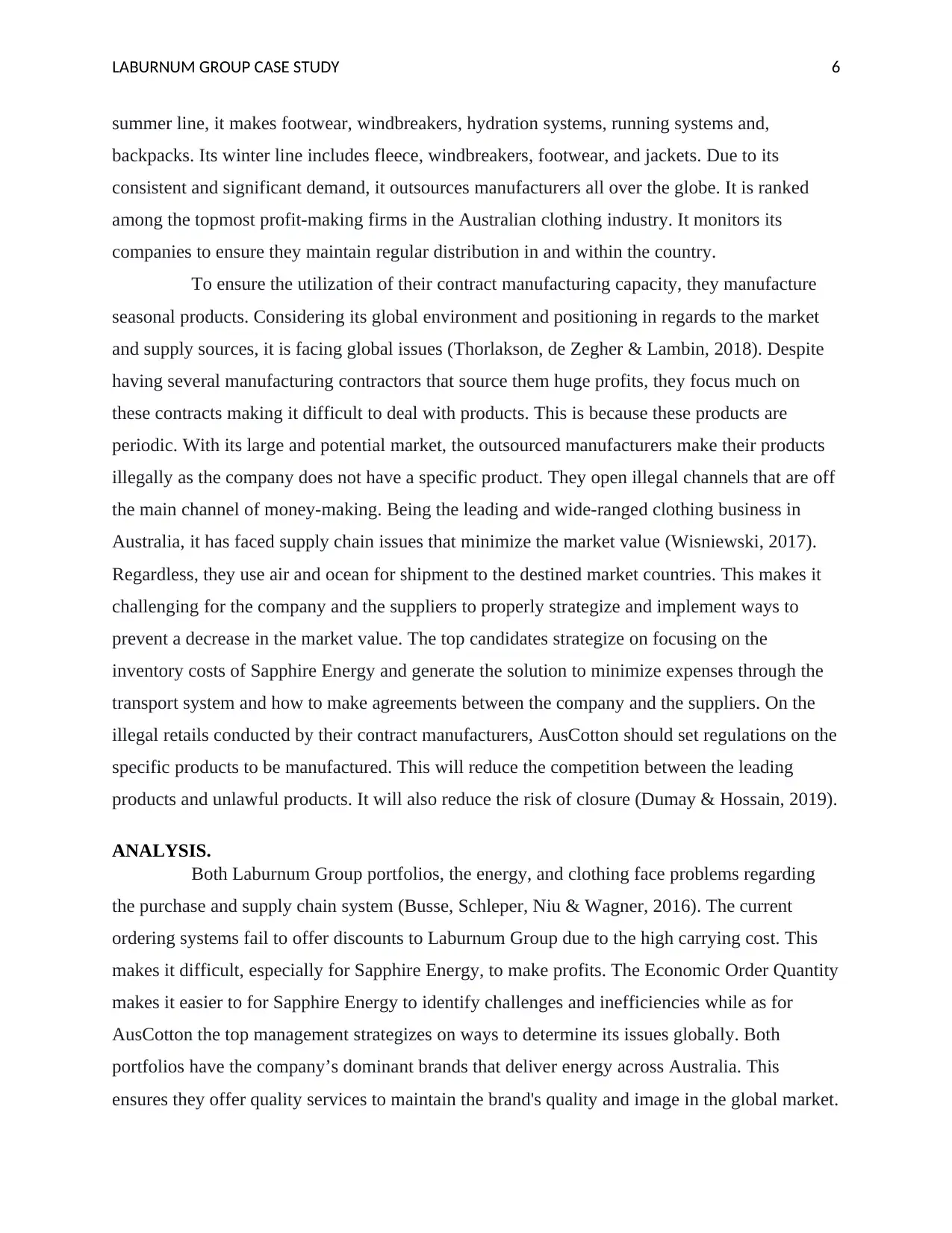
LABURNUM GROUP CASE STUDY 6
summer line, it makes footwear, windbreakers, hydration systems, running systems and,
backpacks. Its winter line includes fleece, windbreakers, footwear, and jackets. Due to its
consistent and significant demand, it outsources manufacturers all over the globe. It is ranked
among the topmost profit-making firms in the Australian clothing industry. It monitors its
companies to ensure they maintain regular distribution in and within the country.
To ensure the utilization of their contract manufacturing capacity, they manufacture
seasonal products. Considering its global environment and positioning in regards to the market
and supply sources, it is facing global issues (Thorlakson, de Zegher & Lambin, 2018). Despite
having several manufacturing contractors that source them huge profits, they focus much on
these contracts making it difficult to deal with products. This is because these products are
periodic. With its large and potential market, the outsourced manufacturers make their products
illegally as the company does not have a specific product. They open illegal channels that are off
the main channel of money-making. Being the leading and wide-ranged clothing business in
Australia, it has faced supply chain issues that minimize the market value (Wisniewski, 2017).
Regardless, they use air and ocean for shipment to the destined market countries. This makes it
challenging for the company and the suppliers to properly strategize and implement ways to
prevent a decrease in the market value. The top candidates strategize on focusing on the
inventory costs of Sapphire Energy and generate the solution to minimize expenses through the
transport system and how to make agreements between the company and the suppliers. On the
illegal retails conducted by their contract manufacturers, AusCotton should set regulations on the
specific products to be manufactured. This will reduce the competition between the leading
products and unlawful products. It will also reduce the risk of closure (Dumay & Hossain, 2019).
ANALYSIS.
Both Laburnum Group portfolios, the energy, and clothing face problems regarding
the purchase and supply chain system (Busse, Schleper, Niu & Wagner, 2016). The current
ordering systems fail to offer discounts to Laburnum Group due to the high carrying cost. This
makes it difficult, especially for Sapphire Energy, to make profits. The Economic Order Quantity
makes it easier to for Sapphire Energy to identify challenges and inefficiencies while as for
AusCotton the top management strategizes on ways to determine its issues globally. Both
portfolios have the company’s dominant brands that deliver energy across Australia. This
ensures they offer quality services to maintain the brand's quality and image in the global market.
summer line, it makes footwear, windbreakers, hydration systems, running systems and,
backpacks. Its winter line includes fleece, windbreakers, footwear, and jackets. Due to its
consistent and significant demand, it outsources manufacturers all over the globe. It is ranked
among the topmost profit-making firms in the Australian clothing industry. It monitors its
companies to ensure they maintain regular distribution in and within the country.
To ensure the utilization of their contract manufacturing capacity, they manufacture
seasonal products. Considering its global environment and positioning in regards to the market
and supply sources, it is facing global issues (Thorlakson, de Zegher & Lambin, 2018). Despite
having several manufacturing contractors that source them huge profits, they focus much on
these contracts making it difficult to deal with products. This is because these products are
periodic. With its large and potential market, the outsourced manufacturers make their products
illegally as the company does not have a specific product. They open illegal channels that are off
the main channel of money-making. Being the leading and wide-ranged clothing business in
Australia, it has faced supply chain issues that minimize the market value (Wisniewski, 2017).
Regardless, they use air and ocean for shipment to the destined market countries. This makes it
challenging for the company and the suppliers to properly strategize and implement ways to
prevent a decrease in the market value. The top candidates strategize on focusing on the
inventory costs of Sapphire Energy and generate the solution to minimize expenses through the
transport system and how to make agreements between the company and the suppliers. On the
illegal retails conducted by their contract manufacturers, AusCotton should set regulations on the
specific products to be manufactured. This will reduce the competition between the leading
products and unlawful products. It will also reduce the risk of closure (Dumay & Hossain, 2019).
ANALYSIS.
Both Laburnum Group portfolios, the energy, and clothing face problems regarding
the purchase and supply chain system (Busse, Schleper, Niu & Wagner, 2016). The current
ordering systems fail to offer discounts to Laburnum Group due to the high carrying cost. This
makes it difficult, especially for Sapphire Energy, to make profits. The Economic Order Quantity
makes it easier to for Sapphire Energy to identify challenges and inefficiencies while as for
AusCotton the top management strategizes on ways to determine its issues globally. Both
portfolios have the company’s dominant brands that deliver energy across Australia. This
ensures they offer quality services to maintain the brand's quality and image in the global market.
⊘ This is a preview!⊘
Do you want full access?
Subscribe today to unlock all pages.

Trusted by 1+ million students worldwide
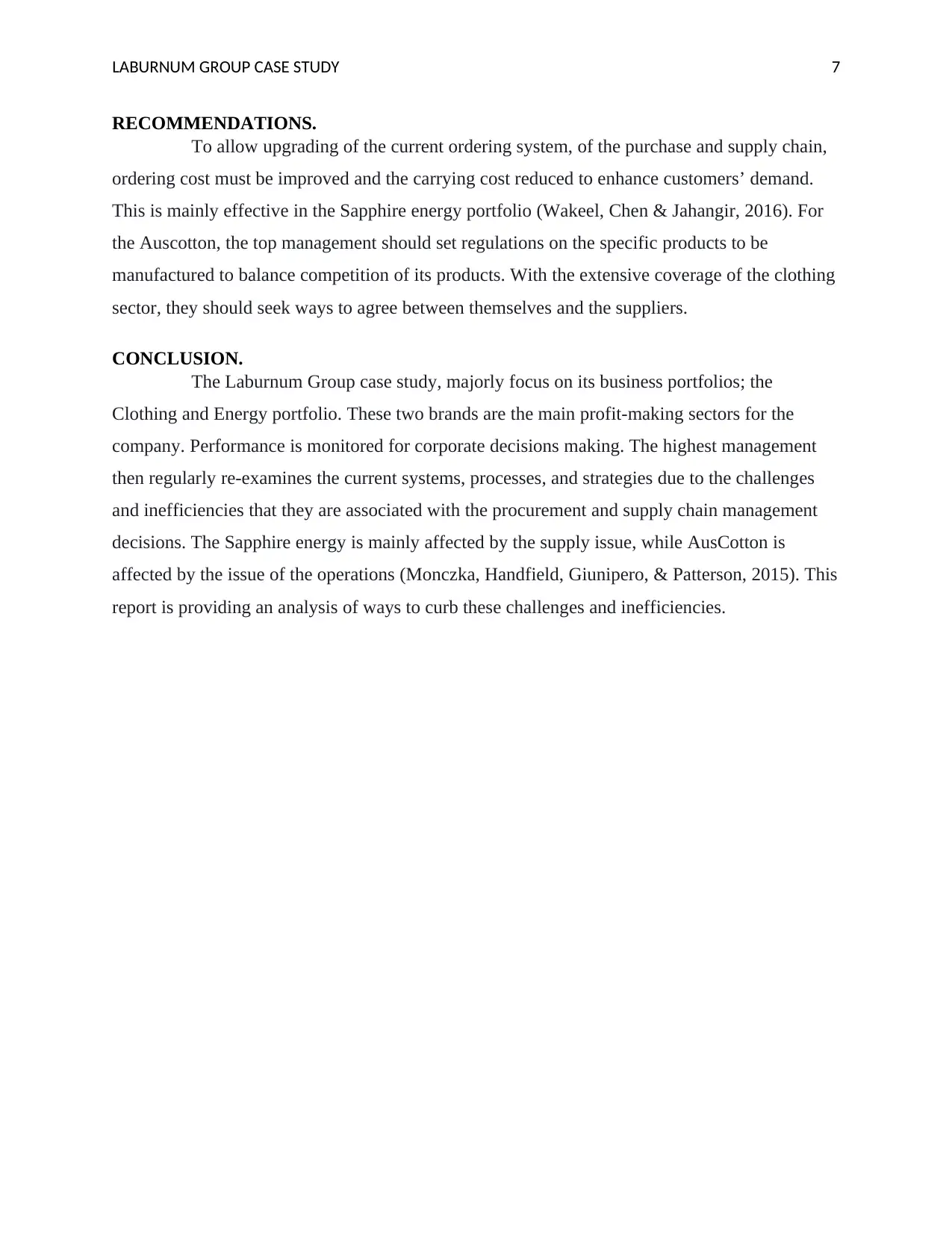
LABURNUM GROUP CASE STUDY 7
RECOMMENDATIONS.
To allow upgrading of the current ordering system, of the purchase and supply chain,
ordering cost must be improved and the carrying cost reduced to enhance customers’ demand.
This is mainly effective in the Sapphire energy portfolio (Wakeel, Chen & Jahangir, 2016). For
the Auscotton, the top management should set regulations on the specific products to be
manufactured to balance competition of its products. With the extensive coverage of the clothing
sector, they should seek ways to agree between themselves and the suppliers.
CONCLUSION.
The Laburnum Group case study, majorly focus on its business portfolios; the
Clothing and Energy portfolio. These two brands are the main profit-making sectors for the
company. Performance is monitored for corporate decisions making. The highest management
then regularly re-examines the current systems, processes, and strategies due to the challenges
and inefficiencies that they are associated with the procurement and supply chain management
decisions. The Sapphire energy is mainly affected by the supply issue, while AusCotton is
affected by the issue of the operations (Monczka, Handfield, Giunipero, & Patterson, 2015). This
report is providing an analysis of ways to curb these challenges and inefficiencies.
RECOMMENDATIONS.
To allow upgrading of the current ordering system, of the purchase and supply chain,
ordering cost must be improved and the carrying cost reduced to enhance customers’ demand.
This is mainly effective in the Sapphire energy portfolio (Wakeel, Chen & Jahangir, 2016). For
the Auscotton, the top management should set regulations on the specific products to be
manufactured to balance competition of its products. With the extensive coverage of the clothing
sector, they should seek ways to agree between themselves and the suppliers.
CONCLUSION.
The Laburnum Group case study, majorly focus on its business portfolios; the
Clothing and Energy portfolio. These two brands are the main profit-making sectors for the
company. Performance is monitored for corporate decisions making. The highest management
then regularly re-examines the current systems, processes, and strategies due to the challenges
and inefficiencies that they are associated with the procurement and supply chain management
decisions. The Sapphire energy is mainly affected by the supply issue, while AusCotton is
affected by the issue of the operations (Monczka, Handfield, Giunipero, & Patterson, 2015). This
report is providing an analysis of ways to curb these challenges and inefficiencies.
Paraphrase This Document
Need a fresh take? Get an instant paraphrase of this document with our AI Paraphraser
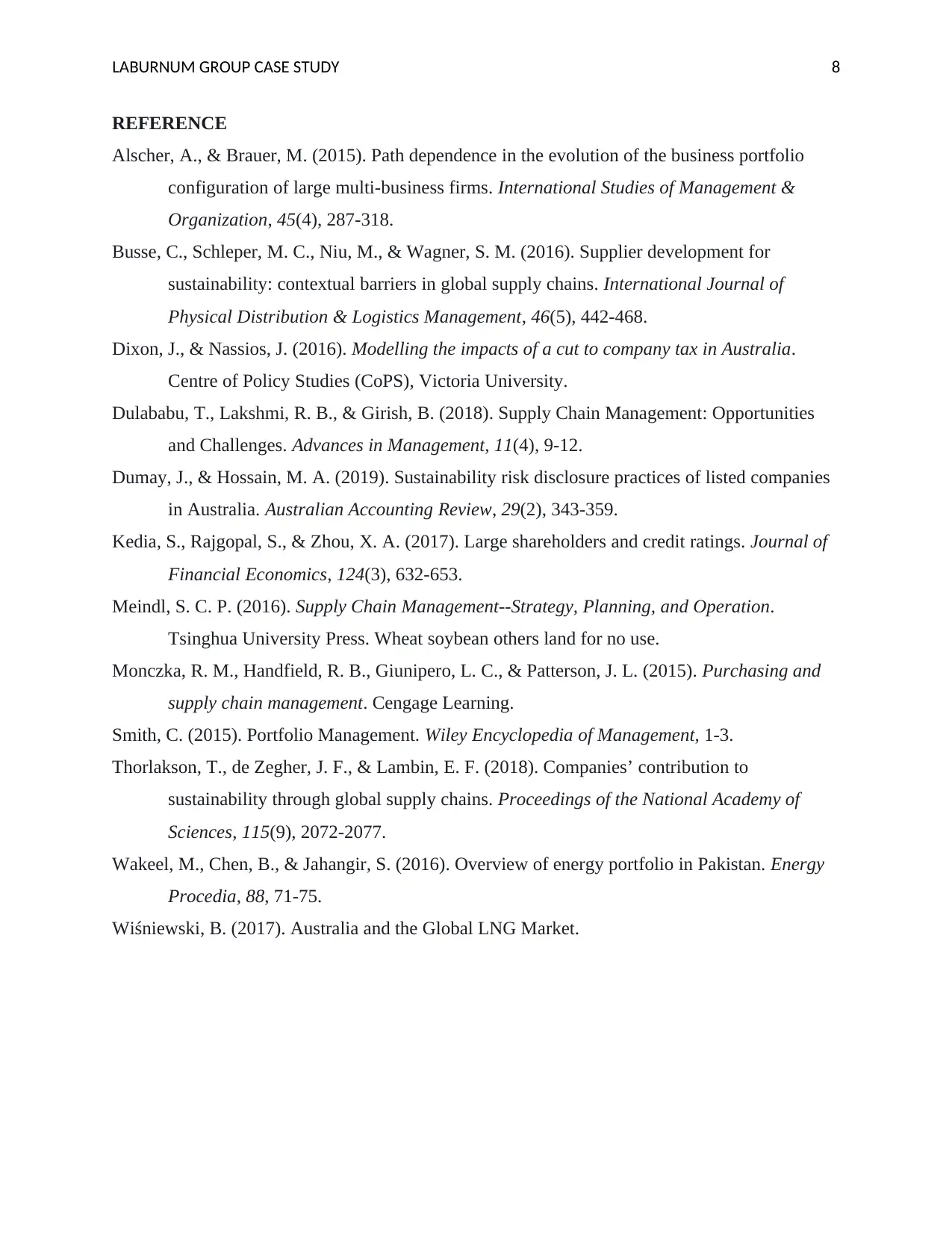
LABURNUM GROUP CASE STUDY 8
REFERENCE
Alscher, A., & Brauer, M. (2015). Path dependence in the evolution of the business portfolio
configuration of large multi-business firms. International Studies of Management &
Organization, 45(4), 287-318.
Busse, C., Schleper, M. C., Niu, M., & Wagner, S. M. (2016). Supplier development for
sustainability: contextual barriers in global supply chains. International Journal of
Physical Distribution & Logistics Management, 46(5), 442-468.
Dixon, J., & Nassios, J. (2016). Modelling the impacts of a cut to company tax in Australia.
Centre of Policy Studies (CoPS), Victoria University.
Dulababu, T., Lakshmi, R. B., & Girish, B. (2018). Supply Chain Management: Opportunities
and Challenges. Advances in Management, 11(4), 9-12.
Dumay, J., & Hossain, M. A. (2019). Sustainability risk disclosure practices of listed companies
in Australia. Australian Accounting Review, 29(2), 343-359.
Kedia, S., Rajgopal, S., & Zhou, X. A. (2017). Large shareholders and credit ratings. Journal of
Financial Economics, 124(3), 632-653.
Meindl, S. C. P. (2016). Supply Chain Management--Strategy, Planning, and Operation.
Tsinghua University Press. Wheat soybean others land for no use.
Monczka, R. M., Handfield, R. B., Giunipero, L. C., & Patterson, J. L. (2015). Purchasing and
supply chain management. Cengage Learning.
Smith, C. (2015). Portfolio Management. Wiley Encyclopedia of Management, 1-3.
Thorlakson, T., de Zegher, J. F., & Lambin, E. F. (2018). Companies’ contribution to
sustainability through global supply chains. Proceedings of the National Academy of
Sciences, 115(9), 2072-2077.
Wakeel, M., Chen, B., & Jahangir, S. (2016). Overview of energy portfolio in Pakistan. Energy
Procedia, 88, 71-75.
Wiśniewski, B. (2017). Australia and the Global LNG Market.
REFERENCE
Alscher, A., & Brauer, M. (2015). Path dependence in the evolution of the business portfolio
configuration of large multi-business firms. International Studies of Management &
Organization, 45(4), 287-318.
Busse, C., Schleper, M. C., Niu, M., & Wagner, S. M. (2016). Supplier development for
sustainability: contextual barriers in global supply chains. International Journal of
Physical Distribution & Logistics Management, 46(5), 442-468.
Dixon, J., & Nassios, J. (2016). Modelling the impacts of a cut to company tax in Australia.
Centre of Policy Studies (CoPS), Victoria University.
Dulababu, T., Lakshmi, R. B., & Girish, B. (2018). Supply Chain Management: Opportunities
and Challenges. Advances in Management, 11(4), 9-12.
Dumay, J., & Hossain, M. A. (2019). Sustainability risk disclosure practices of listed companies
in Australia. Australian Accounting Review, 29(2), 343-359.
Kedia, S., Rajgopal, S., & Zhou, X. A. (2017). Large shareholders and credit ratings. Journal of
Financial Economics, 124(3), 632-653.
Meindl, S. C. P. (2016). Supply Chain Management--Strategy, Planning, and Operation.
Tsinghua University Press. Wheat soybean others land for no use.
Monczka, R. M., Handfield, R. B., Giunipero, L. C., & Patterson, J. L. (2015). Purchasing and
supply chain management. Cengage Learning.
Smith, C. (2015). Portfolio Management. Wiley Encyclopedia of Management, 1-3.
Thorlakson, T., de Zegher, J. F., & Lambin, E. F. (2018). Companies’ contribution to
sustainability through global supply chains. Proceedings of the National Academy of
Sciences, 115(9), 2072-2077.
Wakeel, M., Chen, B., & Jahangir, S. (2016). Overview of energy portfolio in Pakistan. Energy
Procedia, 88, 71-75.
Wiśniewski, B. (2017). Australia and the Global LNG Market.
1 out of 8
Related Documents
Your All-in-One AI-Powered Toolkit for Academic Success.
+13062052269
info@desklib.com
Available 24*7 on WhatsApp / Email
![[object Object]](/_next/static/media/star-bottom.7253800d.svg)
Unlock your academic potential
Copyright © 2020–2025 A2Z Services. All Rights Reserved. Developed and managed by ZUCOL.




![Supply Chain Management Report for Laburnum Group - [Course Code]](/_next/image/?url=https%3A%2F%2Fdesklib.com%2Fmedia%2Fsapphire-energy-auscotton-challenges_page_2.jpg&w=256&q=75)